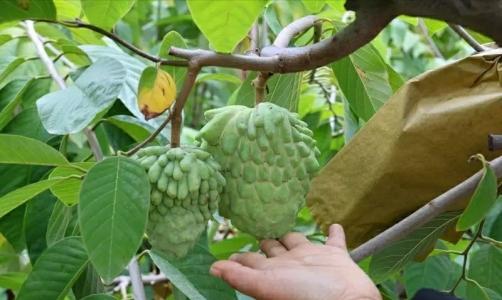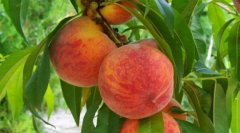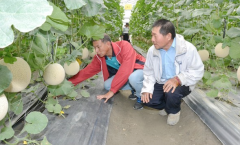The management method of planting technology of pineapple Sakyamuni fruit, and how to pick pineapple Sakya fruit during harvest.
Not many people have heard of the name pineapple Sakya, and even fewer people have tasted its pulp flavor. It is different from Taitung Sakya in fruit shape and taste. Pineapple Sakya is sour, sweet and Q, and its taste is very special, especially during the rainy season and drought.
When I bought farmland more than ten years ago, pineapple Sakya was very popular. Because it is an emerging fruit, the retail price is more than 100 yuan per jin, which can be regarded as a high cash crop. However, the good times do not last long. With the rapid increase in planting area and excess production in only a few years, the retail price (medium price) per jin is only about 30 yuan, and the output value is lower than that of other fruit trees, such as peaches, loquats, etc., and the maturity of immature split fruit cultivation techniques is not easy to master, resulting in too much understock of sellers. These situations have been insurmountable. In recent years, farmers have said that the area of waste farming or cutting and transplanting other fruits and vegetables is very large. Now the quantity on the market is very small.
The pineapple Sakya will lose its leaves in winter, and it needs to be pruned too finely before germination and differentiation in spring. The "fruiting branch" leaves about half to one foot (depending on the thickness of the branch). The "fruiting branch" will leave a fruit in the future. how many "fruiting branches" will of course depend on personal experience, leaving too many fruit grains will naturally become smaller. After flowering and fruiting, the leaves should be left with about 20 pieces and coring, and the unfruitful "fruiting branches" can be cut down to one foot. Pull out the back three leaves. Let it blossom and bear fruit again.
To prevent fruit flies, I mostly hang yellow sticky plates and bag them with plastic bags one inch in size. After that, the cotton sprouts are unbagged, so that their natural enemies, green embroidered eyes, can be scavengers.
Yee pollination is the most labor-saving pollination of pineapple Sakya, but sometimes pollination is not complete, so the growth is not large, and the shape of the fruit is not beautiful. the general tenancy is due to the use of pesticides, and the ground is bare because of herbicide spraying, so there is no night pollination at all, so artificial pollination has to be adopted, and artificial pollination also has advantages, such as beautiful fruit shape, as far as non-toxic cultivation is concerned, insect pollination plus artificial pollination is certainly foolproof. It's just that I didn't work that hard... The natural one is good.
The harvest of Sakya pineapple is also a great knowledge. We need to correctly judge its maturity. It is not ripe enough. In the future, it will blacken and harden and cannot be eaten. If it is too ripe, it will crack or fall on the tree. The fruit after harvest should be put in room temperature to allow it to ripen after ripening. For example, it may not be ripe after being stored in cold storage. After ripening, the fruit will crack, and the peel will soften, blacken or brown. Cut with a knife when eating, and the flesh will be white. The pericarp and seeds can not be eaten, and those that cannot be eaten can be refrigerated, such as peeling and freezing, juice can be beat without thawing, pineapple Sakyama smoothie, although the cultivation techniques of pineapple Sakya have not been greatly improved in recent years, but in terms of non-toxic cultivation, the quantity and quality of the harvest are better than before, which is worth comforting.
Postscript: because of its high sweetness, eaters are afraid of being fat, and its nutritional value has never been published. I hope that a research unit can study its nutritional value and publish it.

- Prev

What are the organic cultivation techniques of peach trees? What are the matters needing attention in organic cultivation techniques of peach trees
Fruit trees are perennial crops, and the growth period after planting is as little as several years , and most of them are 50 years. Therefore, the environmental conditions are closely related to fruit tree cultivation. The environment of fruit tree cultivation is roughly related to climate (air temperature, rainfall, sunshine, wind), soil (moisture, ventilation,
- Next

Taiwan cantaloupe new variety Tairi hybrid, what are the characteristics of Kaohsiung No. 2 tangerine melon? how sweet is it?
The muskmelon "Kaohsiung No. 2-Orange Queen" in the mixed-race queen greenhouse of Taiwan and Japan has a sweet and delicious pulp and is easier to grow than those imported from Japan. Qingnong Su Jingwei has been successfully planted in Changzhi Township, Pingtung County. The agricultural reform farm in Kaohsiung District held a new variety demonstration and tasting meeting.
Related
- The first cup of black tea in spring, the flavor and history of tea gardens in Kenya, Africa
- The computer can not only choose potatoes, but also grow tea rice. AI will grow winter oolong tea champion.
- It is not only the inflated tea bitten by insects, but also engraved with the four seasons tea in Beipu.
- The Oriental Beauty Tea Festival in Zhuxian County takes the stage at the weekend to experience the plus-size feast of oil tea.
- & quot; Oriental Beauty Tea & Exploration of Emei in Hsinchu, the hometown of quot;
- The new variety of strawberry "Tainong 1" dessert is the first choice with mellow aroma. Crimson gorgeous
- History of Tea in Taiwan: from Wild Inner Mountain to Export Tea Garden
- Two types of Taiwan Oriental Beauty Black Tea won the British three-Star Award for Childhood Tea Xiang Zhang Jiaqi changed from pilot to champion tea maker.
- Banana species and varieties: the planting history of Taiwan Xianren banana and dwarf banana is long, is banana disease resistant?
- Coffee planting Technology: Qianjie Coffee from Seedling to harvesting

